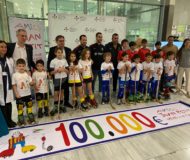

The Sant Pau Research Institute (IR Sant Pau) and the Fundació Amics Joan Petit Nens amb Càncer have launched an innovative project aimed at improving the quality of life for children with cancer who need to undergo a bone marrow transplant. This initiative seeks to demonstrate that physical exercise prior to the procedure, tailored to their functional abilities, can be safe and provide significant benefits during the treatment process.
With a budget of €100,000, the project will run for three years. The necessary funds are being raised through various charitable activities organised by the Fundació Joan Petit. Among these is the campaign “Let’s Fill the Roller Hockey Rinks with the Joan Petit Bracelet,” driven by the Catalan Skating Federation, which encouraged athletes and fans to purchase a solidarity bracelet to support young patients and their families. This campaign is set to be repeated early next year. Funds already raised have been delivered to kick-start the project, and future initiatives are expected to help complete the total budget.
On Tuesday, 26th November, a ceremony was held in the lobby of the Hospital Sant Pau, where the Fundació Joan Petit delivered funds raised through the Catalan Skating Federation. The event also featured a symbolic hockey match played by children from different teams, held in the corridors of the hospital’s Paediatrics ward. Players from F.C. Barcelona, Xavier Barroso and Sergi Aragonès, participated alongside coach David Cáceres, and handed out gifts to the hospitalised children.
During the event, Joan Torner, president of the Fundació Joan Petit Nens amb Càncer, highlighted the resilience shown by children facing cancer, drawing a parallel with roller hockey: “In hockey, when you fall, you must get up and keep playing. Similarly, these children teach us every day that despite setbacks, you must rise and move forward with strength and hope.”
The project, named HIIT-FIT-KIDS-ALLO-T-TRIAL, is a pilot programme combining supervised physical exercise for children and adolescents preparing for an allogeneic haematopoietic progenitor transplant (allo-HPT). This medical procedure replaces diseased bone marrow with healthy marrow and is used to treat conditions such as leukaemia, lymphoma, and certain hereditary syndromes. While this treatment significantly increases survival rates, it also raises the risk of cardiovascular complications, exacerbated by the side effects of chemotherapy and radiotherapy.
The project’s innovative approach involves implementing a prehabilitation programme —planned and supervised exercise before the transplant— to strengthen the patients’ physical condition. According to Dr Roser Álvarez-Pérez, principal investigator of the project and researcher in the Paediatrics group at IR Sant Pau, “although the concept of prehabilitation has been successfully tested in adults, it remains an unexplored field in paediatrics. This project aims to improve patients’ functional capacity and cardiovascular function, preparing them to face the transplant in better physical condition while minimising the impact of prolonged hospitalisation.”
The study comprises three key phases: before, during, and after the transplant. The first phase, known as prehabilitation, begins four to six weeks before the procedure and includes a tailored exercise programme based on the patient’s functional capacity, assessed through tests such as blood analysis, electrocardiogram, echocardiogram, and an exercise stress test.
During the hospitalisation phase, supervised exercises will be performed daily in the patient’s room, conditions permitting. Post-hospitalisation rehabilitation will continue for six months, combining in-hospital sessions with activities that patients can carry out at home.
The intervention group will participate in a structured programme incorporating high-intensity interval training (HIIT), a method alternating short periods of maximum effort with rest, optimising results even with limited time. In contrast, the control group will receive conventional care, including standard physical activity recommendations for these patients, but with less structured exercise.
Ensuring the safety of the programme is a priority, with evaluations to rule out contraindications such as fever or low platelet counts. “The primary goals of the study are to determine the programme’s feasibility —whether children can consistently participate given treatment limitations— and its safety, ensuring it does not cause additional complications,” Dr Álvarez adds.
In addition to immediate benefits, the project aims to promote long-term healthy habits, integrating exercise as a key component of medical treatment. According to Dr Álvarez, “just as pre-season training improves fitness to face competition, prehabilitation with exercise prepares patients to tackle the challenge of the transplant with more energy and strength.”
With a planned duration of three years and an estimated annual participation of 15 patients, this innovative programme could lay the groundwork for future multi-centre research and establish prehabilitation exercise as a fundamental tool in paediatric cancer treatment.
This project not only represents progress in paediatric medicine but also serves as an example of how collaboration between institutions and community support can profoundly impact the lives of children facing severe illnesses.
